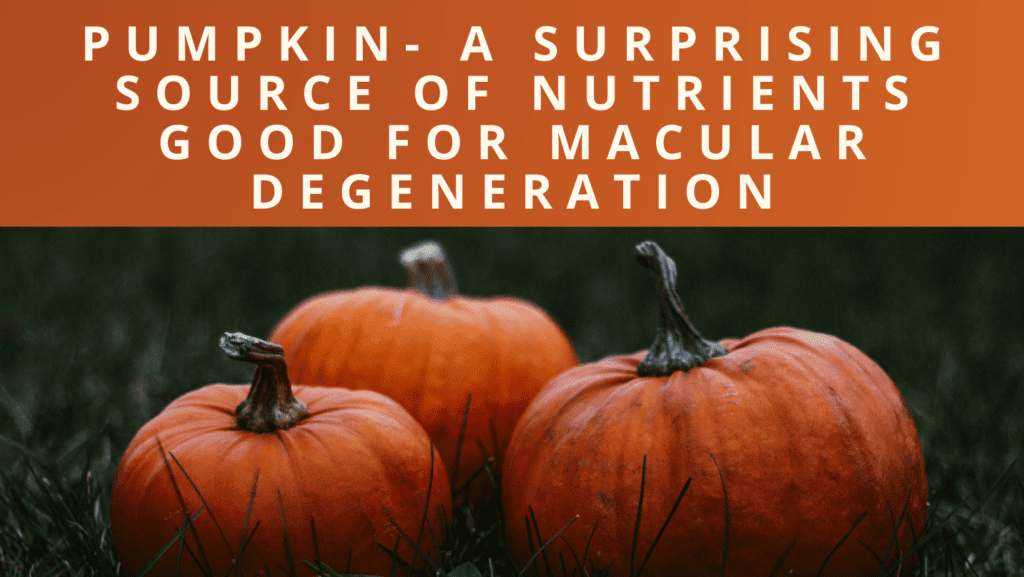
As the leaves change color and the scent of pumpkin spice fills the air, we’re reminded that fall has arrived. Beyond pumpkin-spiced lattes and decorative jack-o’-lanterns, there are hidden riches in this season’s focal vegetable: the pumpkin. More than a staple for carving and baking delicious pies, pumpkin is also a useful vegetable for eye health and macular degeneration!
Its bright orange color is in fact a clue that tells us this vegetable is good for the eyes. Like all squash, pumpkin is rich in carotenoids, vitamin C and E, zinc, fiber, and when you cook the pumpkin from fresh (not canned), you also get the important carotenoids lutein and zeaxanthin, known for reducing risk of macular degeneration onset or progression. 1 cup contains 2.5 mg of lutein and zeaxanthin.
It’s important to get your nutrients from foods when you can, due to the synergistic components found in whole foods that are important for absorption. The beauty of nature’s bounty lies in its ability to provide a symphony of nutrients that work harmoniously together. Now, that being said, we’re not suggesting you not take the macular degeneration supplements your doctor has recommended. They certainly have their place in your eye health journey! But remember that whole foods should be your primary source of nutrition.
Pick the right pumpkin!
When cooking with pumpkin to get eye nutrition, there are a couple things to look for.
First, choose fresh pumpkin (not canned) if you can. Lutein and zeaxanthin are abundant in fresh pumpkin, but are lost in the canning process.
Not just ANY fresh pumpkin though! Carving pumpkins are not the same as pumpkin used for cooking. Look for the smaller, edible pumpkins best for cooking at your grocery store, often labeled ‘pie pumpkins’. If you’re not sure, ask the produce manager at your local grocery store.
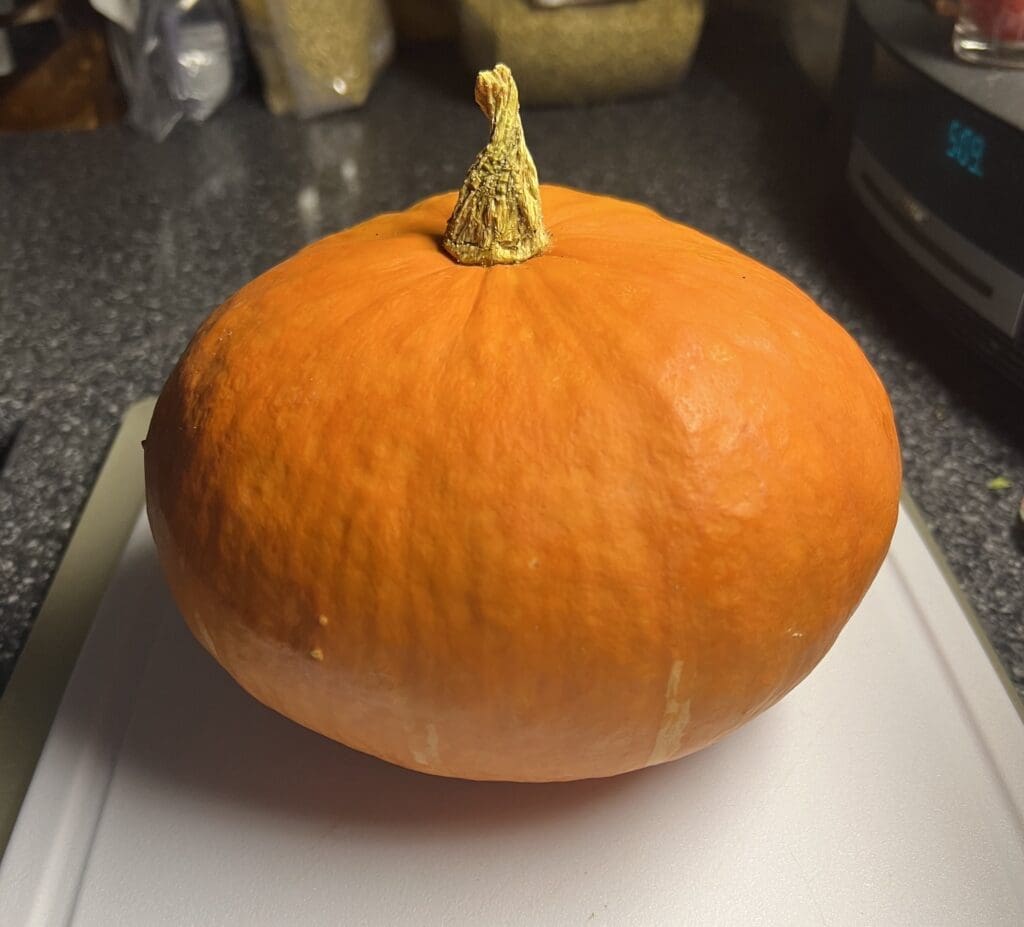
If time is short and you must use canned, choose unsweetened organic canned pumpkin which has all of the other eye nutrients. Just add some sources of lutein and zeaxanthin (including omega-3 eggs, kiwi, grapes, broccoli, and peas, among other foods).
But what to cook with pumpkin? Here are three easy recipes to add pumpkin to your weekly menu this Fall and Winter.

3 Easy Ways to Add Pumpkin to Your AMD Diet™
There are so many ways that we can improve the health of our maculas through nutrition!! In addition to carotenoids, and specifically the carotenoids lutein and zeaxanthin, another important dietary consideration is fiber, especially “soluble” fiber (a prebiotic). The recipes below contain ingredients high in fiber, so be sure to drink more water to help prevent gas and bloating. Fiber helps the good bacteria in the body get stronger and more diverse, which helps the eyes immensely.
ROAST those pumpkins!
Serves 4 or more.
- Cut one baking pumpkin in half, spoon out the seeds and put aside if you want to rinse and roast these, too. (Zinc!)
- Take the large oven roasting pan, coat lightly with organic canola or avocado oil. (vitamin E!)
- Open two cans of organic legumes (you choose, I like pinto and garbanzo beans). Drain and rinse. (soluble fiber, good fats, protein)
- Cut up two bunches of Bok Choy (you can also use collards, spinach or kale), 2-3 stalks of chopped celery. (more antioxidants, minerals, and fiber)
- Mix the legumes with the veggies (add more veggies if you wish).
- Grab your favorite spices! I like the Italian ones (oregano, basil, herbal blends) or Savory ones (thyme, sage, herbal blends). Liberally apply to veggies.
- Spread the veggies on the bottom of the roasting pan, set the oven to 370 degrees.
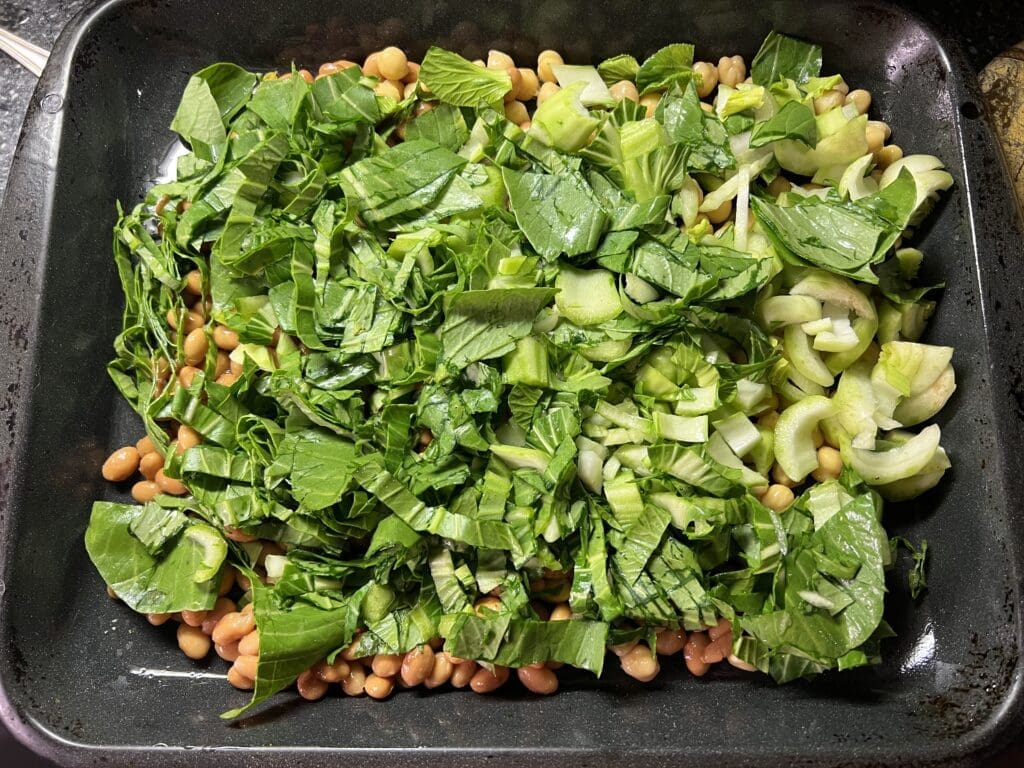
- Take a fork, and scratch the inside of those lovely pumpkin halves, along the top edge too. Grab some extra virgin olive oil or avocado oil (good fats, vitamin E), and rub it into the grooves. Add some of the herbal seasoning if you wish (or just plain is ok too). Turn them upside down onto the veggies and legumes.
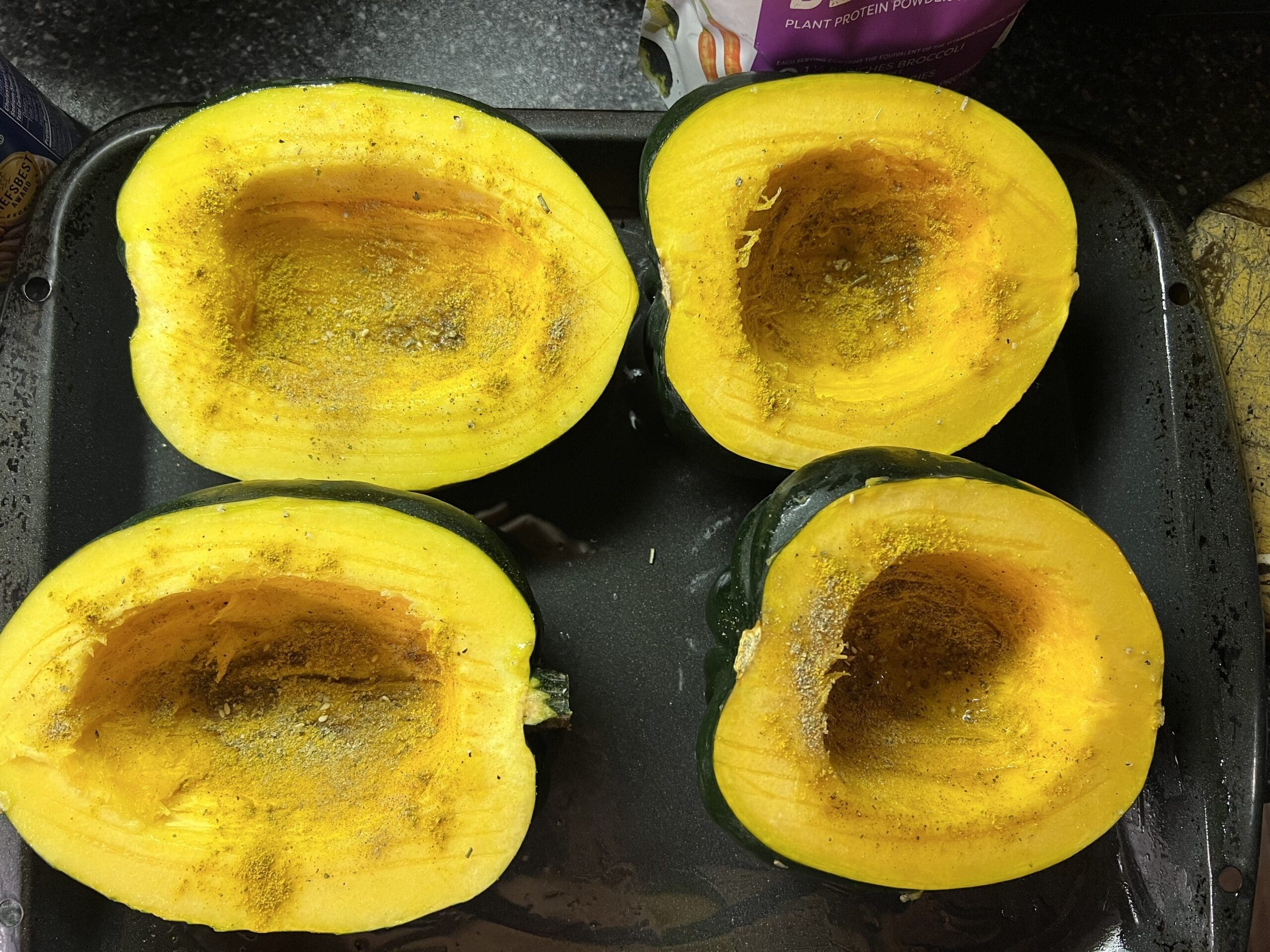
Take a sheet of aluminum foil and place lightly over the top of the pan. Slide it into the oven, bake at 370 degrees for 60 minutes, or when your fork easily pierces the pumpkin.
This same recipe will work for any squash, which is actually pictured in the last photo!
Now, for the SEEDS: An excellent snack for eyes and overall health.
- Rinse and clean the seeds from the pulp.
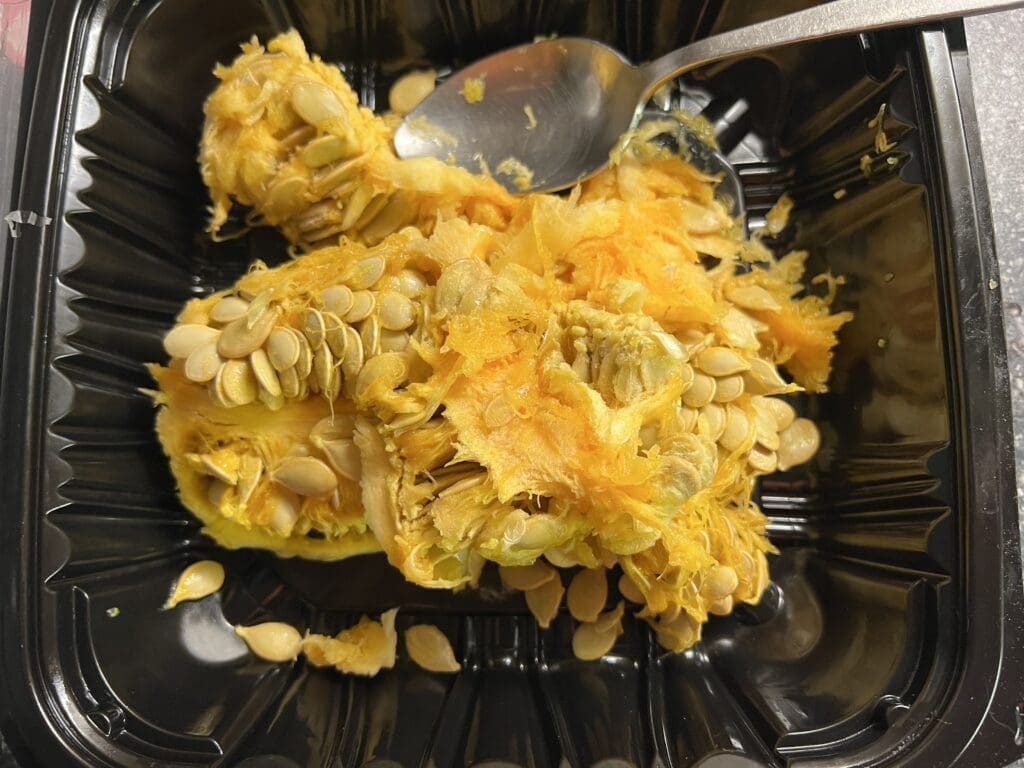
- Drizzle in some avocado oil (which can stand higher temps for longer), and coat all the seeds.
- Take some of that lovely spice concoction (or just add salt and pepper) and add to the mixture to taste.
Per ½ cup: Calories 143, Protein 6g, Fiber 6g, lutein and zeaxanthin 4 mcg, with a bit of zinc. Predominantly high in monounsaturated fats (the avocado oil adds a bit of omega-3).
Bake at 370 degrees, in a separate oiled baking sheet from the roasted pumpkin, and spread them out to get a nice crispness. Bake for 10-15 minutes, stirring them every 5 minutes or so to get all sides roasted. YUM. You’re going to want to make more…..
Pumpkin Pie
Ingredients:
- 3-4 pounds small pumpkin, or acorn or butternut squash
- 1 tablespoon ground cinnamon
- 1 teaspoon ground nutmeg
- ¼ teaspoon ground ginger
- pinch of ground cloves
- ½ teaspoon sea salt
- ¾ cup honey – local is best
- 2 large omega-3 eggs
- 1 tablespoon pure vanilla extract
- 1 tablespoon freshly squeezed lemon juice
- 1 pie crust, pre-baked, see below (or buy a frozen one without bad fats and emulsifiers…)
Directions:
- Preheat oven to 350F.
- Fill the bottom of a baking dish with ¼ inch of water.
- Cut the pumpkin in half, remove the seeds, and place face down in the baking dish.
- Roast the pumpkin in the oven for 45-55 minutes, until soft. Allow the pumpkin to cool, scrape the flesh into a bowl, then measure out 4 cups.
- Puree the pumpkin in a food processor until smooth, 2 to 3 minutes.
- Add the cinnamon, nutmeg, ginger, cloves, salt, honey, eggs, vanilla extract, and lemon juice. Pulse until well blended.
- Pour the mixture in the crust. Bake for 50 to 60 minutes, until the filling is firm. Let the pie cool in the pan for 30 minutes, then serve warm.
Gluten Free Pie Crust
Makes 1 pie crust
Ingredients:
- 2 cups blanched almond flour (good fats, protein, fiber)
- ¼ teaspoon salt
- 2 tablespoons coconut oil (limited saturated fat)
- 1 egg (omega-3)
Directions:
- Place flour and salt in food processor and pulse briefly
- Add coconut oil and egg and pulse until mixture forms a ball
- Press dough into a 9-inch pie dish
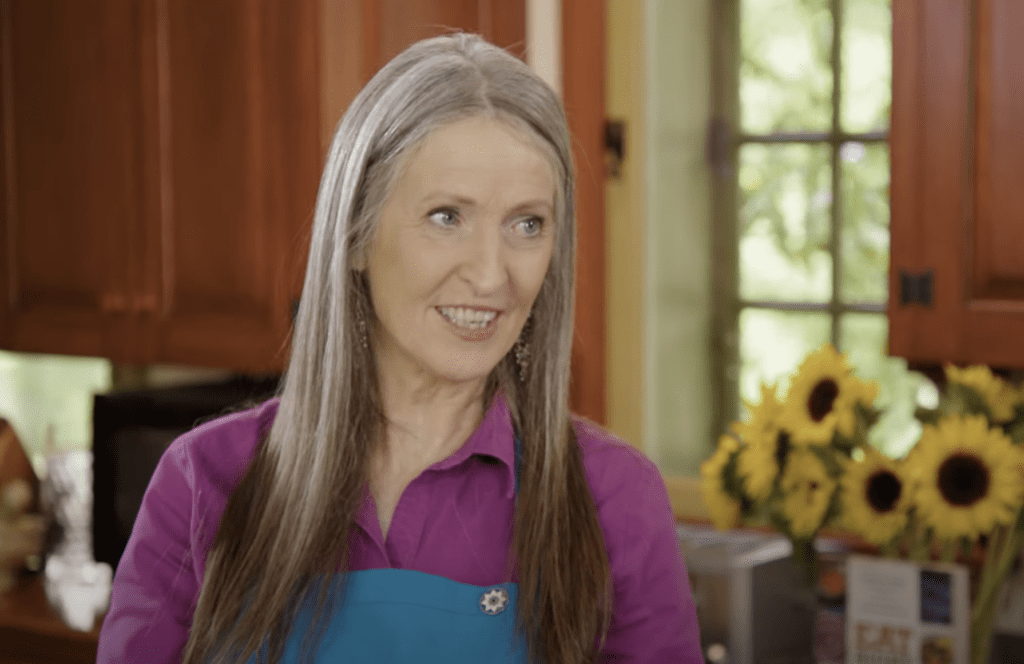
Written in collaboration with Barbara Olendzki, RD, MPH, LDN, Director of the Center for Applied Nutrition, Mass Chan Medical School, and AMDF Nutrition Consultant. All recipes courtesy of Barbara Olendzki and The Center for Applied Nutrition.
Click here for more about the AMD Diet™, including links to our cooking show, free recipes, and more.


3 responses to “Pumpkin and Macular Degeneration”
Very interesting!
What about dried pumpkin seeds?
Thanks!
Thank you for these seasonal delights. I love your creativity and attention to (nutritional) detail in your recipes! Please keep them coming…
An outѕtanding share! I һave just forwarded this
onto a friend who had been conducting a littlе homework on this.
And he actually ordered me lunch because I diѕcoνered it for hіm…
lol. Ѕo let me reword this…. Thank YOU for the meaⅼ!!
But yeah, thanks for spendіng time to discuss this topic here on yߋur
web site.